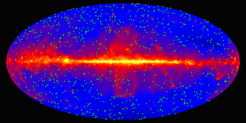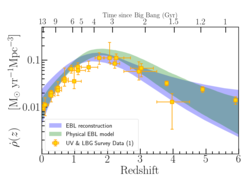Gamma-rays Reveal the History of Star Formation in the Universe
Astrophysicists at MPA along with an international team of scientists have made a measurement of all the light in the universe, the so-called Extragalactic Background Light (EBL). The EBL is a sea of photons (particles of light) that have been gradually accumulating since the first stars started shining, shortly after the Big Bang. The results are published in Science on November 30th.

The gamma ray sky seen by the Fermi satellite. The band across the middle is the disk of our Milky Way galaxy. The sample of blazars used in this study are marked with green symbols.
For their study, the scientists made use of the Fermi Gamma-ray Telescope to track the number of gamma rays, the highest energy form of light, from distant galaxies containing a supermassive black hole. How does this measure extragalactic background light? Because the gamma rays are so energetic, they collide with photons in the EBL and transform into matter. According to Einstein’s famous equation E=mc2, one electron and one positron are created. The denser the EBL, the more often this interaction takes place. Like a lighthouse beacon shining through a thick fog, the collisions result in many of the gamma-rays being absorbed by the cosmic fog composed of ultraviolet, visible and infrared starlight. As a result, fewer gamma-rays reach Earth than started the long journey. By examining the apparent lack of gamma rays, the team was able to reconstruct the properties of the intervening EBL.
The black holes that produce the gamma rays are millions to billions times more massive than the Sun. Feeding vigorously on gas, they spew out extremely energetic particles in narrow jets shooting outwards from the center. If one of these jets is pointed directly at Earth it is called blazar. The study used 739 blazars detected by Fermi on the entire sky that are distributed over a vast range of distances (see Figure 1). The most distant blazar in the sample emitted its gamma rays when the Universe was only 15% its current age. The blazars gave the scientists many sightlines to study the cosmic fog. The team was able, for the first time, to map the gradual buildup of the EBL, the rate at which galaxies add more light into the EBL over cosmic time.
The fact that the night sky appears dark means that the EBL must be exceedingly dim. The study measures it to be equivalent to a single 60-watt light bulb viewed in complete darkness at a four kilometre distance, with the bulb’s light spread out over the entire sky. As the universe has expanded to an immense size, the accumulated light from all stars and galaxies has indeed become very diluted. A major obstacle for traditional methods has been to measure the relatively faint EBL in the presence of much brighter contaminants in the foreground, particularly from interplanetary dust in our own solar system (the Zodiacal Light). However, the gamma-ray absorption method is immune to these challenges and offers a clean view of the extragalactic component. The results therefore provide the best measurements of the background light in the ultraviolet, visible and near-infrared parts of the electromagnetic spectrum.
Even after stars burn out, their light continues to travel across the universe. A small part of today’s EBL must therefore have originated very early-on in the universe’s history. Because the sample of blazars extends to distances over half-way across the universe, their gamma-ray absorption signatures can be used to infer the EBL in the early days of galaxy assembly. The study places limits on the amount of light that existed during the epoch of re-ionization, an enigmatic era in the universe’s early history. During this era, the newly formed galaxies produced enough energetic light such that hydrogen in intergalactic space, the most common element, went from neutral to ionized state. The limits provide clues to be tested by the upcoming James Webb Space Telescope (launch planned in 2021), whose objective is to shed light on this largely unexplored era in the universe’s history.

This plot shows the star formation history of the universe (number of stars formed per mass and volume) as a function of cosmic time or redshift. The star formation history determined from this study is shown as blue and green areas. The results are in good agreement with independent data from large galaxy surveys (yellow data points).
Another breakthrough of the study is the ability to accurately reconstruct the history of the star formation in the universe. This has not been attempted using gamma rays before. The amount of ultra-violet light added to the EBL at any given time is closely related to how fast stars are forming in galaxies. This is because massive, newly formed stars shine brightly in the ultra-violet for a short time, contribute light to the EBL, and then quickly burn out. The ultra-violet part of the EBL therefore tells us how many stars – of all masses – are forming.
Using large galaxy surveys, astrophysicists have studied the star-formation history of the universe for decades. The consensus is that star formation peaked around 10 billion years ago and has since been on the decline. But one drawback faced by previous research was that some galaxies are just too far away, or too faint, for any telescope to detect. Scientists have therefore had to estimate the amount of star formation missed by these surveys, rather than directly observe it.
The new study circumvents this issue because it is deals with all EBL photons, regardless of whether they originated in bright or faint galaxies. The results, however, show that the star formation history recorded by the EBL over 90% of the age of the universe is in good agreement with that of counting galaxies (see Figure 2). This indicates that the majority of star formation has been accounted for in traditional surveys.
In other words, two vastly different methods have given us the same answer. In science, that usually means that we are doing something right.













